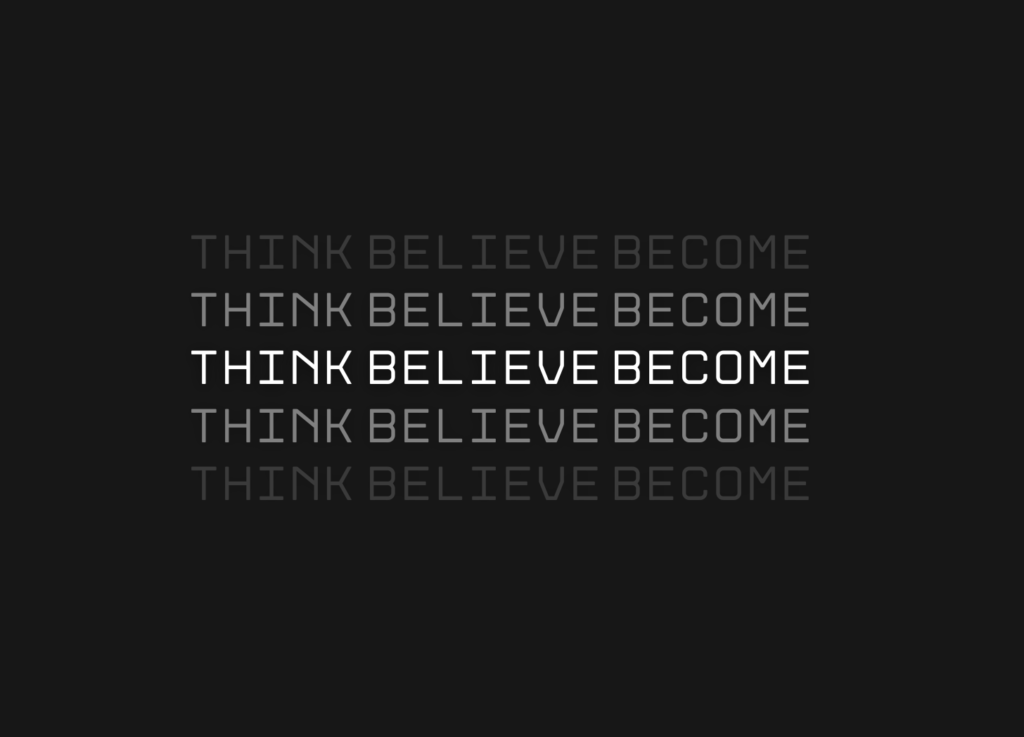
The mental models that transform thoughts into reality and help you figure out “How to Think, Believe, and Finally Become”.
I didn’t do anything much in the month of March.
No writing, filming, or follow-ups on the side hustles I started.
I kept getting emails regarding my trial periods ending soon and didn’t even bother making any payments after it ended.
I was switching between deleting and installing social media apps on my phone.
Looking at others and thinking about how they are doing it. It’s so hard for me to even keep going.
I have all these ideas, but something always stops me from making them real.
Sound familiar?
What separates those who transform ideas into reality from those who remain stuck in planning?
After diving deep into research, I’ve noticed it’s not resources, connections, or luck—it’s the mental algorithms they run.
Today, I’m sharing a framework that’s already beginning to change my approach, and I believe it could transform yours too:
Think it. Believe it. Become it.
The “Thinking” Algorithm: Where Everything Begins
I was watching a video on YouTube and a person mentioned something that stuck within me: “Your life moves in the direction of your strongest thought.”
Queen’s University researchers uncover brain-based markers of new thoughts and they discover that we have more than 6,000 thoughts each day.
But here’s the kicker—a Harvard study found that 47% of our waking hours are spent in thought patterns disconnected from what we’re actually doing.
Everything begins as a thought. As you know our mind processes more than 6000 thoughts per day, but only a fraction of these become meaningful. The quality of your life is determined by which thoughts you choose to bring to reality.
I’m capturing my most frequent thoughts. Which ones I’m feeding? Which deserves more attention? Which ones energize me? Which drain me?
What I’m doing differently now: For the past two weeks, I’ve been documenting my most frequent thoughts in a simple notes app. I’ve created three categories:
- Energy-giving thoughts – Ideas that excite me when they appear
- Energy-draining thoughts – Repetitive worries that leave me exhausted
- Action-triggering thoughts – Ideas that naturally make me want to do something
70% of my thoughts were in the energy-draining category. No wonder March was a wash.
I encourage you to do the same
Remember that thoughts are like seeds—they grow where attention flows.
The “Believe” Compiler: Where Thoughts Gain Power
When Elon Musk announced SpaceX’s plan to build reusable rockets in 2011, aerospace experts called it impossible. Boeing and Lockheed Martin executives publicly stated reusable rockets were economically unfeasible.
NASA had abandoned the concept after spending billions on the Space Shuttle program.
The aerospace industry’s belief was clear: rockets were single-use vehicles—period.
However, Musk and his team operated on a different belief algorithm. After multiple explosive failures and near-bankruptcy, SpaceX successfully landed a Falcon 9 rocket in December 2015.
Today, reusable rockets are standard, cutting launch costs by over 90%. As of 26 March 2025, SpaceX has successfully landed Falcon 9 boosters 408 times. Individual boosters have flown as many as 26 flights.
What changed? Not the laws of physics—belief systems did.
Research at Stanford provides the science behind this phenomenon. In their research, those who believed their intelligence could grow (growth mindset) significantly outperformed those who believed intelligence was fixed—regardless of initial test scores.
This isn’t just positive thinking; it’s neuroplasticity in action. When you believe growth is possible, your brain physically forms new neural pathways to support that reality.
When I was at school, I believed I couldn’t speak in public without anxiety. After changing that belief and practicing for years I reframed this belief. Now I lead meetings every month and speak comfortably to groups of 15-20 people.
Same brain but, a different algorithm.
The “Becoming” Engine: Where Consistent Action Creates Reality
James Clear wasn’t born an author.
He started by committing to publish two articles every week, regardless of circumstances. After 127 weeks without missing a single post, his readership had grown from zero to over 100,000 subscribers.
“Atomic Habits” became a multi-million copy bestseller not by accident, but through algorithmic consistency.
Neuroscientist Dr. Andrew Huberman explains why this works:

“Repetition is the language of the nervous system.” When we repeat actions aligned with our beliefs, we’re literally rewiring our neural circuitry.
Forming a new habit takes anywhere from 18 to 254 days, with the average being 66 days. The becoming process isn’t instantaneous—it’s iterative.
I can relate to this:
When I was in college, I spent 2 years as a dedicated night owl. Waking up early seemed genetically impossible for me. Then in 2019, my work role changed, requiring me to report at 7 AM with a 45-minute commute.
In the beginning, it was brutal. But I showed up consistently from Tuesday to Saturday each week. Eight weeks later, I was naturally waking up around 5 AM—something I previously considered beyond my capabilities.
The key was consistency, not perfection. I didn’t wake up early every single day at first. I didn’t immediately love it. But the algorithm of repeated action eventually rewired my system.
Putting It All Together: My Current Journey
I’m applying this full framework to build a consistent writing practice and other projects that stalled in March.
- Think: I’ve identified that writing gives me energy and purpose when I actually do it
- Believe: I’ve replaced “I should be a writer” with “I am a writer who shows up weekly”
- Become: I’m showing up every week for this ALGORITHM_ newsletter, even when I don’t feel like it
The transformation isn’t instant, but it’s real—and that’s the beauty of life algorithms. They work subtly but powerfully when executed with patience.
In my upcoming newsletters, I’ll share the specific techniques I’m using to debug my mental algorithm when it gets stuck. Because even the best algorithms need troubleshooting sometimes.
P.S. If you found value here, the algorithm works better when shared. Forward this to someone who might benefit from rethinking their thinking.

Leave a Reply